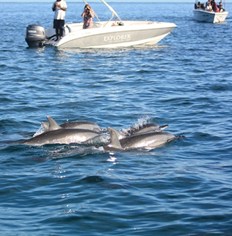Project History
In the 90's we launched a "Marine Mammals" unit, which focused on the identification, protection and preservation of cetaceans. Its first success was in 1990 when it set up the legislation banning the use of drift-nets in the Mauritian waters. Furthermore, in 1991, thanks to the financial help obtained from the United Nations Environment Programme (UNEP) and other sponsors, the MMCS published a poster and an identification booklet on cetaceans living in the Indian Ocean. Again with the financial support of the UNEP, the MMCS carried out an awareness campaign for the general public in both Mauritius and Reunion Island, the aim being the protection and preservation of dolphins and whales.
In Mauritius, this campaign focused on the continuation of the marine mammal identification study in the region; using existing data from identification cards and the writing of a final report making an overall assessment of this study. An awareness program for the general public was conducted through the press, conferences and a drawing contest. The whole project was placed under the responsibility of Mrs Jacqueline Sauzier, for both Mauritius and Reunion Island.
Despite these awareness activities, marine mammals were not well known in Mauritius since few studies had been done in this region of the Indian Ocean. However, the few observations recorded by the MMCS since 1994 on local marine mammals, have shown the great richness of the local marine biodiversity.
In 1999, Delphine Legay, undertaking her doctorate on the behaviour of spinner dolphins (Stenella longirostris) in Tamarin Bay, started an awareness programme on cetaceans.
In order to assist with the funding of her research, she started the Dolphin Watching activity by taking tourists out to observe the dolphins. She managed these activities herself with the concern of not disturbing the animals. Since her death in 2001, the Dolphin Watching activity increased significantly in the western region due to a growing interest in these marine mammals, creating an easy income opportunity.
Unfortunately, nautical activities developed in a very disruptive way, due to the lack of knowledge on the marine environment. The main activities on the west coast were: deep sea/big game fishing, dolphin and whale excursions combined with snorkelling and diving activities on the reefs. The disruption of the Dolphin Watching activity was clearly visible. Everyday dozens of boats chased the dolphins without any respect or consideration for their well-being. Simultaneously, the reefs were being damaged by boat anchors as these excursions became more frequent.
In 2003, the Ocean Alliance organisation, whose main mission is the conservation of cetaceans and their marine environment through research and education, came to Mauritius as part of an expedition for a study on sperm whales in Mauritian waters (biopsy, photo-identification, and acoustic studies). As part of the education programme of this project, they organised animated activities in schools in collaboration with the MMCS. They provided information on the biology and ecology of cetaceans living in the Indian Ocean which also showed that sperm whales living in the coastal waters of Mauritius are as harassed as the dolphins in Tamarin Bay. These scientists actively encouraged a sustainable management project of the marine mammal population of Mauritius.
The increased awareness among the Mauritians and the political threats to the Mauritian marine environment created a favourable opportunity to establish a two year project in June 2006, titled the "Sustainable Management of the Dolphin Watching activities through awareness programmes and education". This project was funded by the UNDP through its Global Environmental Fund Small Grants Programme (GEF SGP).
Despite one year of the awareness campaigns led by MMCS and other NGOs, various aspects of this activity worsened:
- a steady increase in the number of boats on the sites
- non-compliance with guidelines regarding distance and speed
- safety concerns for both clients and animals due to increased number of people swimming with the dolphins
In May 2007, the MMCS was financially supported by the TOTAL Enterprise Foundation for Biodiversity and the sea. It supports projects linked to the preservation of species and marine and coastal ecosystems. Through this foundation, the project's continuity was guaranteed up until 2010, with a large part of the funding dedicated to scientific research on dolphins and coral reefs on the west coast of the island. The project was named "Sustainable Management of Marine Resources, Cetaceans-Reefs in Mauritius".
Expertise was requested from Dr. Vic Cockcroft (Centre for Dolphins Studies, South Africa), specialist in dolphin ecology and the Dolphin Watching activity, who conducted a site visit. Considering the stage that the activity had reached, he advised that only a regulation accompanied by a drastic control of the activity would improve the conditions to observe dolphins.
The MMCS, at its level, was encouraging the Government to take the necessary measures to regulate the activity. The results of this monitoring were submitted to the Tourism Authority in 2007 in order to inform them of the urgency of the situation and the necessity to create proper regulations for the industry.
Throughout this project, the scientific research allowed us to obtain information that would contribute to a better knowledge of the local marine environment. We could define the status of the coral reefs of the region as well as obtain data on the dolphin populations of the west coast.
Finally, the results obtained from the project have made the Dolphin Watching activity more sustainable, being referenced in the creation of a better management plan of the activity.
The ultimate goal was the development of a law regulating the Dolphin Watching activity, which was achieved in March 2013, when such a law was finally implemented.
Monitoring of the animals and the activities continues and the general public continues to be educated about the marine ecosystem and increasingly contributes to its protection.

